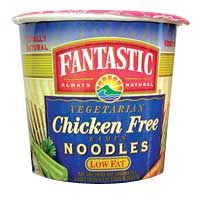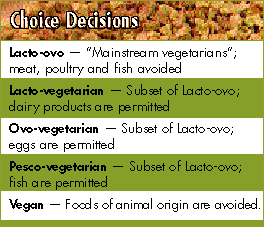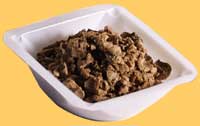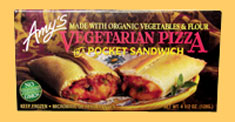
People choose a vegetarian lifestyle for many reasons.
1. Health. Vegetarian diets, which are low in saturated fat, are used to reverse coronary artery disease, control Type II diabetes, and lower the incidence of hypertension.
2. Environmental Concerns. It takes 7 lbs. of grain to produce 1 lb. of beef. Eating lower on the food chain is kinder to the environment since more people are fed with less land resources.
3. Safety Concerns. E.Coli- and Salmonella-contaminated meats have caused high-profile cases of illness. Also, Mad Cow (BSE) disease has been found in Canada. BSE, thought to cause a variation of Creutzfeldt-Jakob disease, has been a public health concern in Europe since 1996. In an April 2001 USA Today article entitled “Europe's Tastes are Changing,” author Ellen Hale noted that market has seen an increased demand for vegetarian choices. For example, in England, McDonald's offers a vegetarian burger on its menu.
4. Animal Rights. Members of PETA and other supporters of animal rights believe in limited use of animals.
5. Spirituality. Seventh Day Adventists reject meat in their diet. Buddhists and Hindus respect the souls of animals and do not consume them.
The term “vegetarian” covers a variety of eating patterns. This impacts how products are formulated. (See “Choice Decision” chart.)
At the highest level, there are two philosophical approaches to formulating vegetarian entrées. The first is to simulate the perception of meat for the consumer. The second is to produce an eating experience that is satisfying without meat. (See “A Non-meat Approach” sidebar.)
The meat simulation approach focuses on consumers that appreciate meat's sensory attributes, but want a non-meat choice. Boca Foods Co. (Kraft Foods, Glenview, Ill.), Worthington Foods (Kellogg USA, Battle Creek, Mich.), Lightlife Foods (ConAgra, Omaha, Neb.), Yves Veggie Cuisine (Hain-Celetial Group, Uniondale, N.Y.), Gardenburger Inc. (Portland, Ore.), Marlow Foods (Astra Zeneca, Middlesbrough, U.K.) and Amy's Kitchen Inc. (Petaluma, Calif.) use this approach. All have products in the frozen foods section of grocery stores.

Soy-based Ingredients
Soy proteins are a good form of meat analogs. Sarwar McDonough's “Evaluation of protein digestibility-corrected amino acid score method for assessing protein quality of foods” (J. Assoc. Off Anal. Chem. 1990; 73: 347-356) noted that soy protein is nutritionally complete, containing all of the essential amino acids.Textured or structured soy protein (TSP) is used in vegetable “burgers.” The different methods used to manufacture and purify soy proteins determine the proteins' functionality. The characteristics desired in the final product determine the selection of the soy protein. Texture, piece size, and protein functionality are considerations.
Soy protein concentrates are traditionally manufactured using aqueous-alcohol to remove the soluble sugars from the soy flour. The resulting, low solubility protein can absorb water but lacks the ability to gel or emulsify fat. These protein concentrates are used to manufacture the textured soy concentrates found in many meat analogs.
Research in the area of the viscoelastic properties of heated gluten and/or soy protein gels has led to the combination of soy protein and gluten to increase the meat-like texture of the product (Apichartsrangkoon, A., 2002. “Dynamic Viscoelastic Properties of Heated Gluten/Soy Protein Gels” J. of Food Science; 67: 653-657). Gluten provides elasticity to the matrix. Textured protein products using combinations of soy protein, gluten, and carbohydrates (starches) are commercially available.
Spun fiber technology can be used to produce fibrous textured protein from isolated soy proteins. The resulting structure closely resembles meat fibers. This option is more expensive, due to high manufacturing costs.
Tofu and tempeh are other forms of soy. Tofu is made by curdling soy milk (a slurry of protein extracted from the bean) and pressing the curds into blocks. Tofu's pH is about 4.2. Its texture is controlled by the amount of water used in the extraction process. A firm or extra firm tofu can replace meat chunks in a formulation. It can be handled or conveyed without significant breakage and can be frozen. Marinating mild-flavored tofu in ingredients of a desired flavor profile can enhance its taste. Marinating requires a minimum of 24 hours with the best results coming after several days.
Tempeh is made by fermenting cooked, de-hulled soybeans with a fungus (Rhizopus oligosporus) at a pH of 4.8 to 5.0. This transforms the beans into a solid cake and makes nutrients more bioavailable. Tempeh is higher in protein and fiber than tofu (Clute, Mitchell, 1999. “Breaking the Mold with Tempeh,” Natural Foods Merchandiser, June).
Tempeh—with a yeasty, nutty flavor—is used extensively in Indonesian cuisine, usually with grains or vegetables. Some chefs prefer the texture of tempeh to tofu for use as a chicken substitute because it has more texture. Tempeh also can be marinated.
Wheat and Quorn Options
Seitan, or wheat gluten, has been used as a protein source in Asia for hundreds of years and is available commercially in the U.S. It is made of dough (flour and water), rinsed to remove the starch components. The texture is modified by the amount of water contained in the gluten mass and by the amount of kneading. Gluten, with more water and/or less kneading, is less dense and puffier. It is bland and light in color, which offers food formulators the options of coloring and flavoring. It has a fibrous nature and meat-like structure. When hydrated, it tears apart like chicken fiber.Quorn is the processed cellular mass obtained from the filamentous fungus, Fusarium venenatum, mixed with a binder, usually egg white or whey protein. It has a meat-like bite, mild flavor and a fibrous structure that resembles chicken muscle tissue. It adds texture without a formulator needing to mask off-flavors. Michael Jacobson of the Center for Science in the Public Interest - CSPI (Washington) has stirred controversy about its use. He has cited anecdotal evidence of consumers vomiting after ingesting Quorn and questions the labeling of the product as “mushroom” based. Although all mushrooms are fungi, not all fungi are mushrooms.
There are also true mushrooms with a meat-like texture and flavor that can be chopped and combined with cooked grains like brown or wild rice, bulgar wheat or rolled oats. There is little piece identity in this type of product. Other vegetable pieces can be included for interest (e.g., carrots or broccoli); flavor (e.g., onions or garlic) or for more complete nutrition (e.g., garbanzo beans and other legumes). Portabellas have been used to replace a meat patty in sandwiches.

Minor but Crucial Ingredients
Whatever a product's base ingredient, other ingredients are needed for a finished product. Each ingredient should be considered for the function delivered in the final food experience, and then a food science approach can be used to select the best ingredients for the job.Binders such as egg whites, tapioca starch, pectin, gums, wheat gluten, whey protein, and isolated soy protein can be used to retain moisture and fat and provide cohesion for the protein mass. Protein binders are useful with the vegetable- and grain-based products. Gums and starches may require specific hydration steps, and the order of ingredient addition often is important for an effective binding system.
Fat can contribute to a realistic mouthfeel and intensify the flavor of the product. Most fats used in the food industry are derived from vegetable sources. However, partially hydrogenated vegetable oils containing trans-fatty acids, although acceptable in a vegetarian sense, may be a negative to the consumer whose reason for choosing meatless products is a healthier lifestyle. In meat replacement products, the melting point, crystallization rate, and crystal type of the fat may not be critical, and substitute fats could be acceptable. “Healthy lipids” such as those containing omega-3 fatty acids also are an option.

An alternate approach is to experiment with the sugar-salt-acid-bitter balance of a formula. Asian chefs have done this for centuries with soy sauce, sweet/ sour or hot/sour flavor combinations.

If a product is a meat substitute, its flavor must be meaty and savory. Once negative flavors are masked, characterizing flavors can be built in. Flavor enhancers such as autolyzed yeast extracts used in combination with hydrolyzed vegetable proteins add meaty notes. Dairy flavors such as cheese or butter add richness. Other accents such as onion, garlic and mushroom, grill and smoke flavors also enhance the profile.

Early Checks Avoid Later Problems
When formulating commercial products for vegetarians, especially vegans, the ingredient source is important. There are animal and non-animal sources for many common ingredients. Also, non-animal ingredients may be processed using parts of animals. For example, dextrose and sucrose have a vegetable source but may be processed through a bone char filter to decolorize them. Glycerin can be animal, vegetable or synthetic in origin. Asking a supplier for this information at the beginning of the formulation process helps ensure an acceptable product.ingredients are not necessarily organically grown, although organic ingredients likely appeal to a greater portion of vegetarian than mainstream consumers. Also, ingredients designated as pareve or kosher are not necessarily vegetarian, for example, gelatin.
Nutritional considerations also are important. Plant sources of protein can provide adequate amounts of the essential amino acids, and research suggests that complementary proteins do not need to be consumed in the same meal to ensure adequate nitrogen retention and use. However, B12 from plant sources such as tempeh, miso, and sea vegetables has been shown to be less nutritionally available. Fortification with a more bioavailable form of B12 should be considered, especially if the target consumer is over 50 (due to decreased absorption of B12 with aging). Calcium and vitamin D fortification of vegan foods also may be appropriate.
And, as any experienced product developer knows, product scale-up often involves formulation alterations.
For example, pasta, such as couscous; grains, such as rice and bulgur wheat; and beans, such as lentils and garbanzos, often are available to the formulator in a pre-processed form. This makes it easier to incorporate them into entrées. A portioned amount of pre-processed couscous can be deposited into a tray with a portion of, for example, Thai Vegetable Stew with a minimal amount of equipment. If the grain or pasta of choice cannot be obtained in a pre-processed form, or if the cooking of the ingredient is essential to texture or flavor of the final product, manufacturing operations are more complex. Consulting with operations and engineering early in the project saves missteps.
An array of ingredients is available to formulators of vegetarian products. Increasing demand for high-quality, flavorful vegetarian food choices could mean that a development project for a vegetarian product may be coming soon to a lab near you.
Website Resources
www.planetark.org/dailynewsstory.cfm/newsid/19563/story.htm— Vegetarianism at U.S. collegeswww.vrg.org/nutshell/about.htm— Vegetarian Resource Group website
www.food.oregonstate.edu/tofu/— Information on tofu characteristics, Oregon State University, Food Resource
www.talksoy.com/Health/t98Symposium3.htm— Flavor technology's impact on product development

Sidebar: A Non-meat Approach
With wheat flour, corn meal, cheese and vegetables—such as tomatoes and bell peppers, Amy's Kitchen (Petaluma, Calif.) turns out a vegetarian product heavily dependent upon, well, vegetables.
In a formulation approach of producing an eating experience that is wonderful without trying to imitate meat, ingredients such as grains, beans, nuts, mushrooms, vegetables and fruits can be utilized. If formulating for Lacto-ovo vegetarians, dairy products and eggs add to the wealth of ingredient choices.

In a mushroom risotto, the cheese adds richness. Aged Parmesan or Asiago cheese provides slightly nutty/meaty notes to the profile.
There is no need to mask flavor in this formulation because all ingredients are used for their contribution to the overall texture and flavor of the final product.